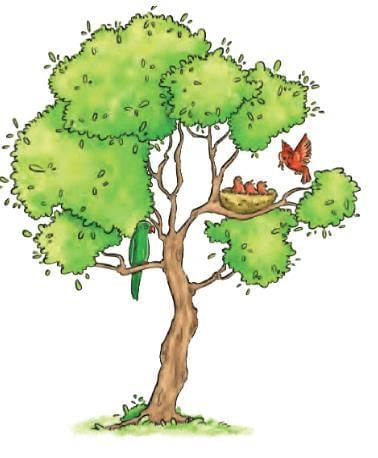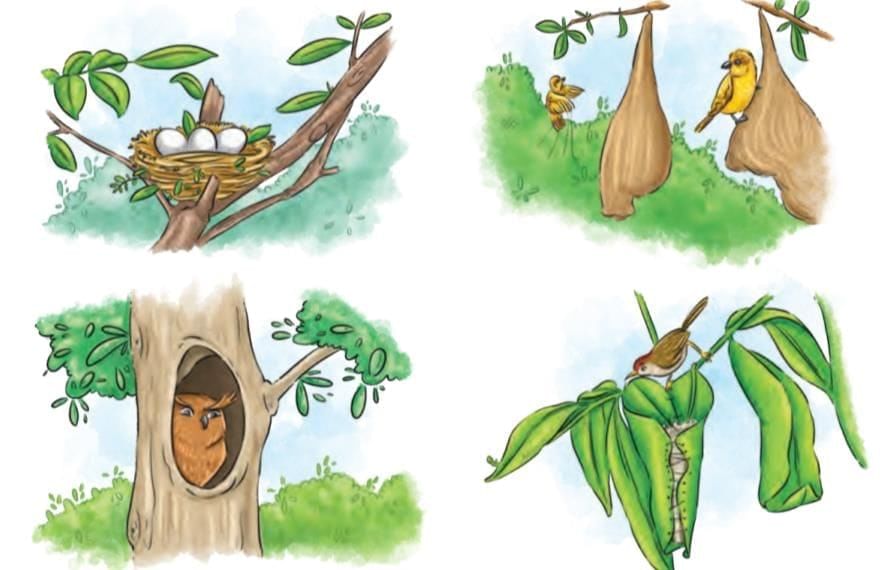Detailed Summary: What a Bird Thought | Chapter Notes For Class 6 PDF Download
| Table of contents |

|
| Introduction |

|
| Key Points of the Poem |

|
| Detailed Summary |

|
| Theme/Message |

|
| Difficult Words |

|

Introduction
This poem takes us on a journey through the poet's life, from the safety of a little house to the wide, mysterious world beyond. It beautifully explores themes of growth, discovery, and the wonder of life's endless mysteries.Key Points of the Poem
- The poem consists of four stanzas.
- The poem is written from the point of view of a bird.
- It describes the journey of a young bird as it experiences the world.
- The bird initially views the world in very simplistic and limited ways.
- As the poem progresses, its understanding of the world becomes broader and more complex.
- The poem highlights themes of growth, discovery, and the innocence of childhood.

Detailed Summary
Stanza 1
I lived first in a little house,And lived there very well,
I thought the world was small and round,
And made of pale, blue shell.
In the first part of the poem, the poet is telling us about their very first home. It was a little house, and they felt happy living there. They thought that the whole world was tiny, like a small round ball, and that it was made of a soft, pale blue shell. Imagine if you had a little toy that looked like a shell; that’s how the poet saw the world. They felt safe and cozy in their little house, just like a baby feeling snug in a blanket.
Stanza 2
I lived next in a little nest,Nor needed any other,
I thought the world was made of straw,
And nestled by my mother.
Now, the poet tells us about the next place they lived, which was a little nest. A nest is a cozy place that birds make to keep their eggs safe and warm. Here, the poet felt just as comfortable and didn’t need anything else because they were close to their mother. The poet thought the whole world was made of straw, which is what nests are made from. Straw is soft and warm, like a hug. The poet felt loved and protected, just like a little chick under its mother’s wings.

Stanza 3
One day, I fluttered from my nest,To see what I could find,
I said the world is made of leaves,
I have been very blind.
In this stanza, the poet is feeling adventurous! They decided to leave their nest and explore the world around them. When they went out, they looked around and noticed that the world was not just a small ball or made of straw; it was full of leaves! Leaves are green and beautiful, and they come from trees. The poet realized that before, they had been “blind,” which means they didn’t see how big and colorful the world really was. It’s like when you close your eyes and think there’s nothing outside, but when you open them, you see everything is bright and full of life.
Stanza 4
At length, I flew beyond the tree,Quite fit for grown-up labours,
I don’t know how the world is made,
And neither do my neighbours.
Finally, the poet talks about flying beyond the tree. The phrase "Quite fit for grown-up labours" means that they have grown up a bit and are ready to see more of the world, like a bird that learns to fly high. However, even with all this new exploring, the poet admits they still don’t really understand how the world is made. This means that even when we grow up and learn many things, there are still mysteries about life that we don’t know, and even the neighbors, or the people around them, don’t have all the answers either. It’s okay to not know everything; life is full of surprises and things to learn, just like when you discover new games or toys.
Theme/Message
The poem takes us through a bird's journey from an egg to the wide and beautiful world outside as it grows and learns to fly.
Theme
The poem talks about how we grow and learn as we experience new things in life. When we are young, we see the world with innocence, but as we grow older, we gain knowledge and understand things better. The poem also shows how nature is full of beauty and has a special way of helping us think and feel. Watching trees, flowers, rivers, and the sky can make us feel calm and happy. Nature teaches us many lessons and helps us connect with the world in a deeper way. Through this journey of learning, we see life from new perspectives and grow wiser every day.Message
The poem teaches us that understanding the world does not happen all at once; it takes time and patience. We learn new things little by little as we grow. It also tells us that being curious and asking questions is very important. When we explore new things and try to understand them, we become wiser. Life is like a big adventure where we keep learning every day. Every experience, big or small, helps us know more about the world around us.Difficult Words
- Nestled: To settle comfortably or snugly.
- Fluttered: Moved lightly and quickly.
- Labour: Hard work or effort.
- Neighbours: Those who live near or next to someone.
- Fit: Suitable or appropriate.
- Evolves: To grow.
- Perception: The way in which something is regarded, understood, or interpreted.
- Complexities: Complications.
- Curiosity: A strong desire to know or learn something.
- Sheltered: Protected or shielded from harm or danger.
- Comfort: A state of physical ease and freedom from pain or constraint.
- Perspective: A particular attitude or way of regarding something; a point of view.
FAQs on Detailed Summary: What a Bird Thought - Chapter Notes For Class 6
| 1. What is the main idea of the poem "What a Bird Thought"? |  |
| 2. What themes are explored in the poem "What a Bird Thought"? |  |
| 3. How does the poet use imagery in "What a Bird Thought"? |  |
| 4. What emotions does the bird express in the poem? |  |
| 5. How can readers relate to the poem "What a Bird Thought"? |  |
















